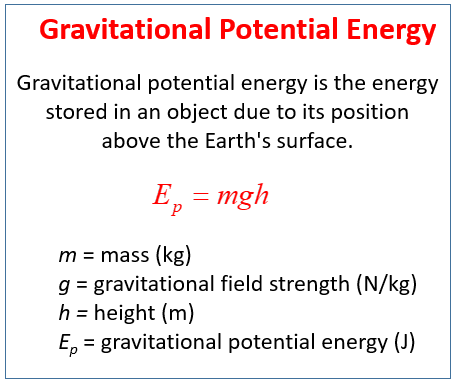Gravitational Potential Energy
Related Pages
Energy Transfers
Mechanical, Potential and Kinetic Energy
Elastic Potential Energy
Lessons for IGCSE Physics
A series of free GCSE/IGCSE Physics Notes and Lessons.
In these lessons, we will
- Describe what is meant by gravitational potential energy.
- Calculate the amount of gravitational potential energy gained by an object raised above ground level.
Gravitational Potential Energy (GPE)
The following diagram gives the formula for gravitational potential energy. Scroll down the page for more examples and solutions on how to use the formula.

Gravitational potential energy is the energy stored in an object due to its position above the Earth’s surface.
This is due to the force of gravity acting on an object. Gravitational potential energy is
calculated as follows:
Ep = m × g × h
Where:
Ep is the Gravitational Potential Energy, measured in Joules (J).
m is the mass of the object, measured in kilograms (kg).
g is the acceleration due to gravity. On earth, g ≈ 9.8 m/s2
h is the height of the object above a chosen reference point, measured in meters (m).
Key Concepts about Gravitational Potential Energy (GPE)
- GPE increases as height increases.
- At ground level, (h = 0), GPE is typically defined as zero.
- Lifting an object converts work into GPE.
- When the object falls, GPE converts to kinetic energy (ignoring air resistance):
\(GPE_{top} = KE_{bottom} \Rightarrow mgh = \frac{1}{2}mv^2\)
Videos
Examples:
- A crane lifts a 75kg mass a height of 8 m. Calculate the gravitational potential energy
gained by the mass (g = 9.8 N/kg).
- A ball with a mass of 500g is lifted onto a shelf which is 1.5m above the ground. Calculate the gravitational potential energy gained by the ball (g = 9.8 N/kg).
Gravitational Potential Energy - IGCSE Physics
Examples:
- How much G.P.E. does a 5kg rock that is 10m above the ground has?.
- A helicopter is flying at a height of 1.5km. If it has 50MJ of G.P.E., what is the mass
of the helicopter?
- A boy throws a 0.2kg rock up with a speed of 5m/s. If all the kinetic energy becomes gravitational potential energy, how high will the stone go?
Try out our new and fun Fraction Concoction Game.
Add and subtract fractions to make exciting fraction concoctions following a recipe. There are four levels of difficulty: Easy, medium, hard and insane. Practice the basics of fraction addition and subtraction or challenge yourself with the insane level.

We welcome your feedback, comments and questions about this site or page. Please submit your feedback or enquiries via our Feedback page.